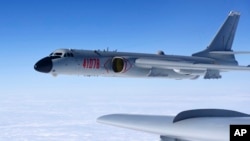China now has the technology, hardware and know-how to coordinate a war from space, defense analysts say.
The People's Liberation Army could park military equipment systems in space or use satellites to surveil the ground, experts say.
China may eventually use sensors to detect enemy submarines at sea, said Richard Bitzinger, U.S.-based visiting senior fellow with the S. Rajaratnam School of International Studies in Singapore.
"The military uses of space are pretty self-evident, and the Chinese would probably be foolish if they did not try and militarize space," Bitzinger said. "It is a part of their explicit package of future reforms for the People's Liberation Army."
China's 2019 white paper China's National Defense in the New Era notes a growing role in space for the People's Liberation Army Air Force.
"In line with the strategic requirements of integrating air and space capabilities as well as coordinating offensive and defensive operations, the PLAAF is accelerating the transition of its tasks from territorial air defense to both offensive and defensive operations," the paper said.
Space hardware could help China carry out airstrikes with multiple missile types, said Andrew Yang, secretary-general of the Chinese Council of Advanced Policy Studies think tank in Taiwan.
Developing capabilities
China's air force will improve its capacity for early warnings, airstrikes and missile defense, the white paper said.
Researchers in China have tested hypersonic weapons — those that can fly at least five times faster than the speed of sound — including space glide vehicles that are launched into space on a rocket, Astronomy magazine reported in November. The country has tested, too, a fractional orbital bombardment system for missiles, the article said, citing reporting by the Financial Times.
China's decades-old network of satellites can do "high-definition" physio-magnetic observation that's good enough to detect military equipment on Earth, said Collin Koh, research fellow at the Institute of Defense and Strategic Studies, a unit of the S. Rajaratnam School of International Studies.
"In the Chinese inventory of space satellites, they have those that are dedicated to ocean surveillance," Koh said. "It has both civilian and potential military application."
Chinese officials are trying to prevent their commercial-use BeiDou Navigation Satellite System from being jammed by a potential adversary, he added.
Where space would meet Earth
The Chinese military would most likely use military technology in space to seek control in the disputed East and South China seas and fend off challenges on the high seas of the Western Pacific just beyond China's near seas, analysts say.
"Chinese doctrine says, 'We need to control the near seas, and we need be able to project force and contest an adversary in the second island chain,' " said Gregory Poling, director of the Asia Maritime Transparency Initiative at the Washington-based Center for Strategic and International Studies.
That agenda represents a threat to Asian countries that contest sovereignty with China over the near seas, said Alexander Vuving, a professor at the Daniel K. Inouye Asia-Pacific Center for Security Studies in Hawaii.
Beijing has already placed military hangars and radar systems on tiny South China Sea islet outposts. Beijing competes there for maritime sovereignty with Brunei, Malaysia, the Philippines, Taiwan and Vietnam. All six parties value the 3.5 million-square-kilometer waterway for fisheries and energy reserves.
China separately claims sovereignty over self-ruled Taiwan, having kept the island on edge for decades against a possible attack.
Eyes on US
The United States, the world's largest military power, has sent warships into the South China Sea and near Taiwan as a warning to China, its former Cold War adversary, against further expansion.
"China is growing in terms of military power," Vuving said. "There is a naval arms race between China and the U.S. China now has more ships than the U.S. China is projected to have the biggest navy in the region, even now by some estimates."
The United States christened the use of space for military purposes decades ago. The U.S. Navy used space for atmospheric and high-altitude research before the U.S. space agency, NASA, was formed in 1958. The U.S. Air Force still launches GPS and missile-defense tracking satellites.
Neither China nor the United States has an "impenetrable" space-based shield against enemy missiles, which then-U.S. President Ronald Reagan sought in the 1980s, Bitzinger said. But, he said, China is trying to be one of the world's top two or three countries in military space.









